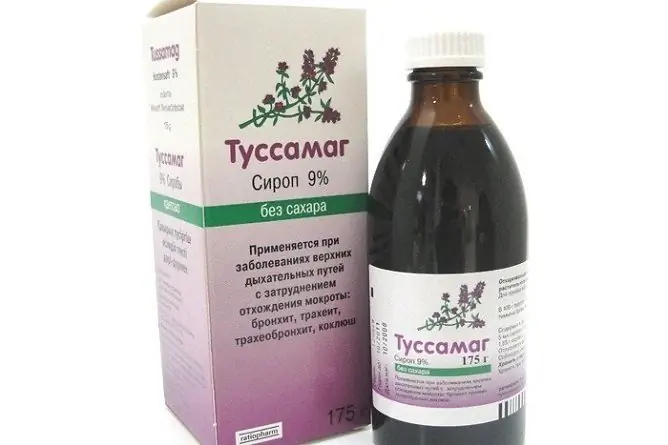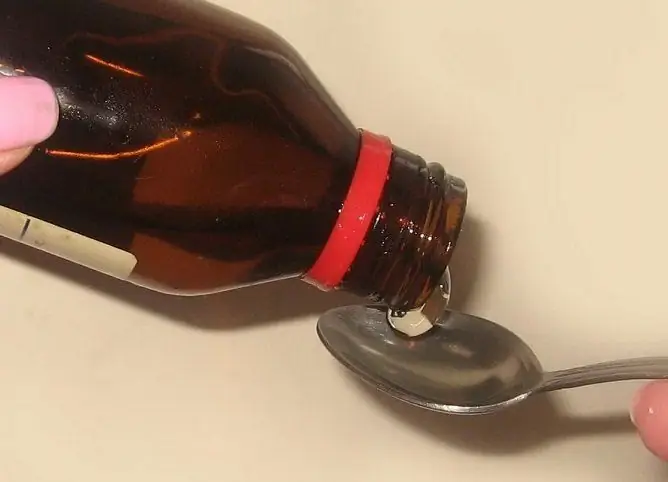- Author Rachel Wainwright [email protected].
- Public 2023-12-15 07:39.
- Last modified 2025-11-02 20:14.
Motinorm
Motinorm: instructions for use and reviews
- 1. Release form and composition
- 2. Pharmacological properties
- 3. Indications for use
- 4. Contraindications
- 5. Method of application and dosage
- 6. Side effects
- 7. Overdose
- 8. Special instructions
- 9. Application during pregnancy and lactation
- 10. Use in childhood
- 11. In case of impaired renal function
- 12. For violations of liver function
- 13. Drug interactions
- 14. Analogs
- 15. Terms and conditions of storage
- 16. Terms of dispensing from pharmacies
- 17. Reviews
- 18. Price in pharmacies
Latin name: Motinorm
ATX code: A03FA03
Active ingredient: domperidone (Domperidone)
Manufacturer: Medley Pharmaceuticals, Ltd. (Medley Pharmaceuticals, Ltd.) (India)
Description and photo updated: 30.11.2018

Motinorm is an antiemetic.
Release form and composition
- tablets: round, almost white or white, with a chamfer, with a line on one side and Medley engraving on the other (10 pcs. in blisters, in a cardboard box of 2, 3, 5 or 10 blisters);
- syrup: a transparent, syrupy liquid of light orange color, with the smell of mint and anise (30, 60 or 100 ml each in dark glass bottles, 1 bottle in a cardboard box).
Each pack also contains instructions for using Motinorm.
Composition of 1 tablet:
- active substance: domperidone - 10 mg;
- auxiliary components: propyl parahydroxybenzoate, methyl parahydroxybenzoate, corn starch, magnesium stearate, lactose.
Composition of 5 ml syrup:
- active substance: domperidone - 5 mg;
- auxiliary components: propyl parahydroxybenzoate, methyl parahydroxybenzoate, sucrose (sucrose), glycerol (glycerin), sorbitol (70% solution, non-crystallizing), lactic acid, propylene glycol, purified water, sunset yellow dye FCF, mint-anise flavor.
Pharmacological properties
Pharmacodynamics
The active substance of Motinorm - domperidone, is a central blocker of dopamine receptors. It increases the duration of peristaltic contractions of the antrum of the stomach and duodenum, increases the tone of the lower esophageal sphincter, eliminates nausea and vomiting, in case of slowing down of gastric emptying, accelerates this process.
Domperidone stimulates the release of prolactin from the pituitary gland. Its antiemetic effect is probably due to a combination of gastrokinetic (peripheral) action and antagonism to dopamine receptors in the chemoreceptor trigger zone. The drug does not affect gastric secretion.
The drug poorly penetrates the blood-brain barrier, therefore, rarely causes the development of extrapyramidal effects.
Pharmacokinetics
Once in the gastrointestinal tract, domperidone is rapidly absorbed. Absorption of the substance decreases with low acidity of gastric contents, as well as in the case of simultaneous intake with food. The maximum plasma concentration is observed after 30-60 minutes.
The substance is characterized by low bioavailability (about 15%). It is widely distributed in body tissues, with the exception of brain tissues - here the concentration is low. It binds to plasma proteins by 91-93%. It is extensively metabolized in the intestinal wall and in the liver.
It is excreted from the body mainly in the form of metabolites: 66% - through the intestines, 33% - by the kidneys. From 1 to 10% of the received dose is excreted unchanged. The half-life (T 1/2) is 7-9 hours.
In patients with severe renal failure (serum creatinine levels above 6 mg / 100 ml, i.e., more than 0.6 mmol / l) T 1/2 increases to 20.8 h, but the plasma concentration of domperidone is lower than in healthy volunteers …
Indications for use
- dyspeptic disorders: a feeling of bloating, belching, heartburn, a feeling of fullness in the epigastrium, flatulence, pain in the upper abdomen;
- nausea and vomiting of organic, functional and infectious origin;
- nausea and vomiting caused by an irregular diet, radiation therapy or drugs (including dopamine agonists such as levodopa and bromocriptine).
Contraindications
Absolute:
- perforation of the stomach or intestines;
- mechanical obstruction;
- gastrointestinal bleeding;
- prolactinoma;
- children under 5 years of age, in acute and subacute conditions (nausea and vomiting), weight less than 35 kg - for tablets;
- hypersensitivity to any component of the drug.
Tablets and syrup Motinorm should be used with caution in the following cases:
- renal / hepatic impairment;
- childhood;
- pregnancy;
- lactation period.
Motinorm, instructions for use: method and dosage
Tablets and syrup Motinorm are taken orally 15-30 minutes before meals and, if necessary, before bedtime.
Recommended dosage regimen:
- adults and children from 5 years old: chronic dyspepsia - 10 mg 3 times a day for 4 weeks, if necessary, the dose can be doubled; nausea and vomiting - 20 mg 3-4 times a day;
- children under 5 years old (only Motorinorm syrup can be used): chronic dyspepsia - 2.5 mg per 10 kg of body weight 3 times a day for 4 weeks, if necessary, the dose may be doubled; nausea and vomiting - 5 mg per 10 kg of body weight 3-4 times a day.
Patients with renal insufficiency are advised to increase the intervals between doses of the drug.
Side effects
- from the gastrointestinal tract: transient intestinal spasms;
- from the nervous system: in children and patients with increased permeability of the blood-brain barrier - extrapyramidal disorders;
- from the side of the psyche: very rarely (mainly in children) - drowsiness, nervousness, agitation, convulsions;
- from the immune system: skin rashes, urticaria;
- others: hyperprolactinemia (gynecomastia, galactorrhea).
Overdose
In case of an overdose of Motinorm, disorientation, drowsiness, and extrapyramidal reactions may occur.
Activated charcoal should be taken immediately after taking an overdose. For symptomatic therapy of extrapyramidal disorders, antihistamines, anticholinergic, antiparkinsonian agents are used.
special instructions
In the form of syrup, Motinorm contains sucrose, which should be taken into account by patients with diabetes mellitus and patients with such rare hereditary diseases as sucrase / isomaltase deficiency, glucose / galactose malabsorption syndrome, fructose intolerance.
With long-term treatment, patients should be under constant medical supervision.
Influence on the ability to drive vehicles and complex mechanisms
In case of development of side effects from the psyche or the central nervous system, patients should be careful when driving vehicles and working with complex mechanisms.
Application during pregnancy and lactation
During pregnancy and lactation, Motinorm syrup and tablets can be used only in cases where the expected benefits outweigh the potential risks.
Pediatric use
The drug is used with caution in pediatrics.
Motinorm tablets are contraindicated in children under 5 years of age. In case of nausea and vomiting, the drug should not be administered to children weighing less than 35 kg.
With impaired renal function
Motinorm in renal failure should be used with caution. The drug is excreted by the kidneys in a small amount, therefore, a single dose adjustment is not required, however, if repeated administrations are necessary, the frequency should be reduced to 1-2 times a day. Reducing the dose of the drug may be necessary in severe renal failure.
For violations of liver function
Motinorm with liver failure should be used with caution.
Drug interactions
Domperidone has no effect on the concentration of paracetamol, digoxin.
Motinorm can be used in conjunction with antipsychotics (neuroleptics), dopaminergic receptor agonists (bromocriptine, L-dopa).
The bioavailability of domperidone is reduced by other antacids, sodium bicarbonate, cimetidine, antisecretory drugs.
Anticholinergics neutralize the effect of domperidone.
The plasma concentration of domperidone is increased by antibiotics from the macrolide group, antifungal agents of the azole series, HIV protease inhibitors, nefazodone.
Analogs
Analogues of Motinorm are Domet, Domperidone, Domstal, Metoclopramide, Motiject, Motilak, Motilium, Motonium, Passages, Perinorm, Ceruglan, Cerucal and others.
Terms and conditions of storage
Store at a temperature not exceeding 25 ° C in a dry place out of the reach of children.
Shelf life of tablets - 4 years, syrup - 3 years.
Terms of dispensing from pharmacies
Available without a prescription.
Reviews about Motinorm
On specialized sites and forums, there are reviews about Motinorm mainly from patients who took it for dyspepsia. They note that the drug is effective both for a course of treatment and for occasional admissions as needed. It effectively relieves nausea, bloating, flatulence, abdominal pain, a feeling of fullness and other accompanying symptoms.
The price of Motorinorm in pharmacies
The price of Motinorm is unknown, since the drug is currently not available commercially. The approximate cost of some popular analogues:
- Motilium: 30 tablets for resorption, 10 mg each - 622-845 rubles, 30 film-coated tablets 10 mg each - 568-855 rubles, 100 ml of a 1 mg / ml suspension - 578-875 rubles;
- Motilac: 30 tablets for resorption, 10 mg each - 268-372 rubles, 30 film-coated tablets 10 mg each - 265-412 rubles;
- Domperidone: 30 film-coated tablets of 10 mg - 58-205 rubles.

Anna Kozlova Medical journalist About the author
Education: Rostov State Medical University, specialty "General Medicine".
Information about the drug is generalized, provided for informational purposes only and does not replace the official instructions. Self-medication is hazardous to health!






